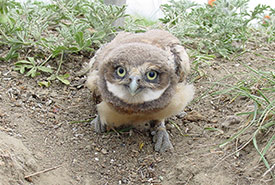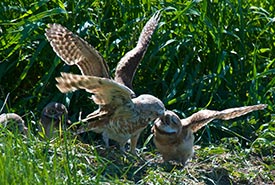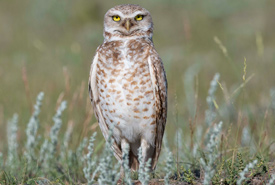Owl hands on deck: Efforts to conserve burrowing owls

Burrowing owl (Photo by Karol Dabbs)
As a communications and engagement intern with the Nature Conservancy of Canada (NCC) in Saskatchewan, I have the opportunity to write and share stories about unique species and I thought writing about burrowing owls would be a hoot! It’s an adorable species and, unlike most owls, it’s active during the day.
Burrowing owls are small, standing only 19 to 20 centimetres tall. While their diet is adaptable to the food sources available, it consists mainly of insects (grasshoppers and beetles) and small vertebrates (mice and voles). They hunt in and around their nesting site during the day and hunt further away in denser grasses and forbs at night. Males gather over 90 per cent of a breeding pairs’ total diet during the 90-day breeding period. After that, both birds hunt fairly equally.
The female starts laying eggs in May, with an average clutch size of nine eggs, the largest of any raptor in North America. About 90 per cent of the eggs will hatch, but often only three to five owlets will fledge. In years when there is a vast amount of food available, nesting success can average eight fledglings. If a clutch is lost early in the breeding season, the pair can potentially lay another smaller one, but generally only one clutch is raised. Interestingly, during the dispersal period, the time when the birds spread out from each other to reduce competition for food and territory (late August), the juveniles after fledging will use five or more burrows before migration.

Burrowing owl feeding its young (Photo by Karol Dabbs)
Burrowing owls prefer sparsely vegetated grasslands occupied with burrows created by other mammals, such as badgers, ground squirrels and black-tailed prairie dogs. In Canada, the majority of the population resides in Alberta and Saskatchewan. A miniscule number of re-introduced burrowing owls also reside in Manitoba and British Columbia (previously extirpated from the province in 1979). The Canadian population heads south for winter in September and October, mostly to Mexico and the southwestern part of the United States (New Mexico, Arizona, California and South Texas).
Since April 1995, burrowing owls are federally endangered in Canada according to the Species At Risk Act. They are also endangered, threatened or a species of concern in various parts of the U.S. (where some of the Canadian population lives in the winter).

Burrowing owl on prairie grasslands (Photo by Jason Bantle)
The first recovery plan for burrowing owls was published in 1995. Nowadays, most monitoring projects have been cancelled because of the lack of sightings due to low population numbers.
NCC recently unveiled a bold and unprecedented plan to rally people and communities to conserve and care for one of the world’s most endangered and least protected ecosystems: Canada’s iconic Prairie grasslands.
The Prairie Grasslands Action Plan will conserve more than 500,000 hectares by 2030 — an area six times the size of Calgary. From food security to carbon storage, grasslands are vital to our health. Grasslands also support wildlife, and unless we act now to conserve and care for what’s left, remarkable species such as burrowing owls, will be gone forever. To learn more, visit prairiegrasslands.ca.

